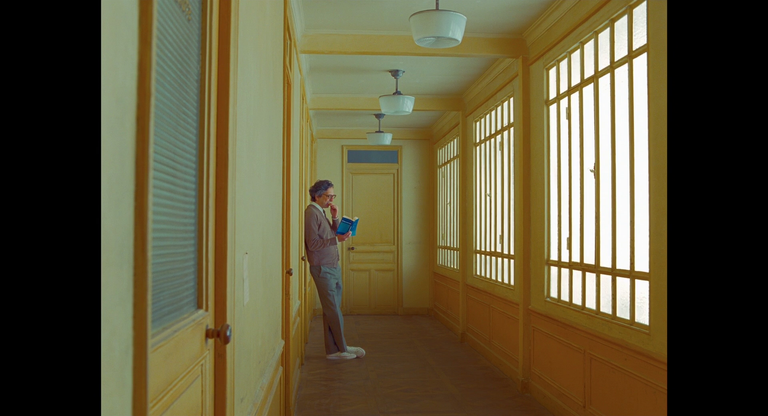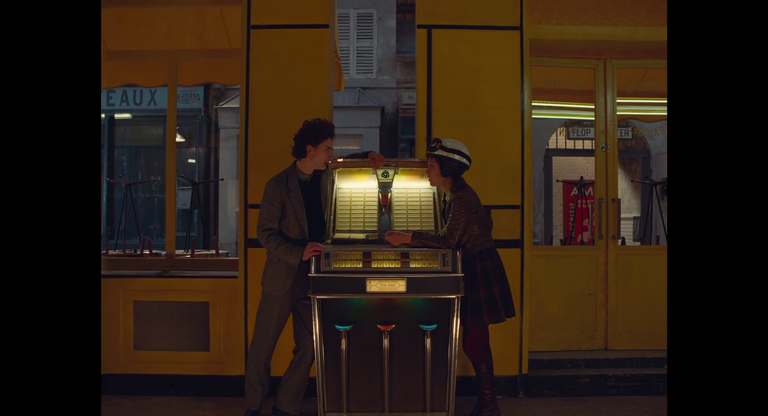'The French Dispatch' by Wes Anderson Review: Beautiful, but seemingly intentionally messy

It's safe to say that Wes Anderson is one of few directors in Hollywood that really pushes a unique style of filmmaking and storytelling. There's truly very little quite like it, taking advantage of relatively tight aspect ratios and depth within the scenes, with a heavy focus on composition, symmetry, and camera movements within his works. Often enough, his films are creations of a true photographer. Each scene is an attempt to craft something beautifully immersive and unforgettable.
While not all of his works are like this, he's certainly approaching these styles more as time goes on. And it's more evident than ever with his most recent film 'The French Dispatch'. Though with an increase in style and pushing his own boundaries, Wes Anderson has created what is probably his most divisive film thus far as fans that have grown familiar with his style and storytelling are given something that's a little different.
Though this is more a problem of a filmmaker becoming rather known for a specific style, and once they utilise that style in new manners in ways that many wouldn't expect, it might not exceed expectations; I felt this in parts even myself as I watched it, where its structure seemed to cause some mild confusion despite the ultimate goal being rather obvious, just easy to miss during such beautiful scenes and performances from its cast.

The French Dispatch is a film that holds a rare structure in modern filmmaking: it tells multiple stories with different characters during its runtime. Each one is loosely related in one way or another, but focuses on much different events, people, and periods of time. Due to this, it often feels both rushed and hard to follow. We aren't given a lot of time to connect to the characters due to this, they simply come and go rather quickly as we finish one narrative and progress into the next. For some, this will be really confusing and one can easily grow tired of attempting to understand the main purpose of the film; however, as mentioned above, it's actually quite a simple purpose, and its structure actually suits it rather well.
The French Dispatch is an American newspaper. Each of its stories are snippets of culture and life that are discovered and documented by its journalists. Interestingly, many large reviews of the film have even considered it to be a love letter to journalism. When you take into consideration the very fact that we're witnessing the events written down and condensed into text form, it makes a lot of sense that we aren't given a whole lot of depth within each narrative, nor are we given much insight into the characters we're given.
I think this allows for the characters to continue to remain more vague, to be obscure and to spark a sense of curiosity in the audience, much like a journalist or documentary filmmaker would in a piece they're creating: they choose to display what they feel is most necessary. It did take me a while to come to this epiphany, and at times even I was starting to question where exactly the film was going, and what had happened to the prior story as its quickly swept aside in favour of another.
The realisation that this was intentional sparked new interest in the film for me, it allowed me to see it under a new light that made me think less of the narrative and where it was heading, and instead follow the events and characters along knowing they were condensed news stories aimed at telling the tales of the many interesting and obscure lives that were lived during the time. Understandably it's all fictional, but it promotes the feeling of humanity as we see the emotional side to many unique characters. Some criminals, some starting revolutions, and some simply being journalists hunting down stories and finding the best ways to convey them to the world.
I believe, however, that there's some confusion that's met when the majority of the cast are rather famous actors. It's easier to connect with them and thus much easier to feel confused once they disappear. It's easy to question whether that was all it had to show, given such large names are ones we recognise and connect to. While Wes Anderson is known for directing films with the same actors, there were many newer faces, but still ones that were a bit too famous for my liking.
I feel that these stories may have had more emotional weight to them if they were portrayed by actors that most were not aware of, ones that the average person would not recognise thus have any prior connection to. Instead of recognising them for prior performances, our introduction to them is under these characters having their stories told by journalists. It didn't bother me too much, but I certainly would've preferred fresh faces.

It wouldn't be a review of a Wes Anderson film without mentioning the colours, compositions, and camerawork. As one would assume: it's truly beautiful in parts. The symmetry works wonderfully alongside the 1.37:1 aspect ratio in which the frame is very tight. The backgrounds have significant depth in them that are often utilised very well through the use of general blocking. The characters are placed at different depths within the scenes which encourages our eyes to travel throughout this tight image in all its corners.
I have always loved this, where cinematic footage doesn't necessarily mean incredibly wide images and slow camera movements. Instead, it can mean very small spaces utilised extremely well, and alongside unique camera movements and angles that simply compliment such decisions. This is found in many moments, where the enclosed space of the scene allows for the camera to slide from left to right, right to left, as it reveals different rooms of a building with many different characters, room setups, and events taking place within them.
These small snippets of footage allow for more visual storytelling, giving characters that have very little screentime more character depth as even their ways of life are quickly and easily displayed to the audience. Particularly where dialogue simply isn't necessary to do so. I can't help but also mention the fact that this style also saves a lot of production money, given it is much cheaper to build small sets and backgrounds and instead pay strong attention to the use of colour and composition within the location, especially alongside the use of heavy symmetry.
It's refreshing that Wes Anderson's style utilises this cheaper, more beautiful style of directing. The simplicity offers beauty in the imagery without compromising narrative, instead, the locations are simply an extension of the narrative. The use of colours often provides context to good and evil, to innocent or the rather rigid. Cold prison environments are gritty but featuring soulless shades of blue and grey, while the good are met with bright colour palettes.

The French Dispatch is shot on 35mm black-and-white film, as well as 35mm colour negative. It utilises these two different film stocks to display the changing of time periods and to highlight specific moments within each story; in particular we see colour when we shift more to the present as to highlight on the changing of time, or we see the colour appear when the film wants to highlight something that, well, certainly would be appreciated more with colour such as a piece of art.
I really enjoyed the ways in which the film did this. It doesn't simply start and switch from colour to black-and-white, but uses colour sparingly when it's simply going to compliment the subject. The use of this also helps spread the understanding of different time periods in which the stories are taking place, as to avoid confusion in the audience. It's rare that we see cinematography that emphasises subjects with the changing from colour to black-and-white, and I certainly wish more films were as creative to do so. Especially given The French Dispatch also changed between aspect ratios in parts.
Without the need again for useless exposition or heavy dialogue, the film simply highlights that which it wants to display. Allowing for the three narratives to flourish instead. This works excellently alongside the journalistic aspects of the film where journalists will highlight key events, people, or subjects in their stories to display their significance to the stories they're telling.

Wes Anderon's 'The French Dispatch' is yet another truly beautiful film. There's no other films made in this age that come close to its style and ability to consider colour, composition, and the ways it tells stories with its characters. It's refreshing to see something like this from Hollywood in the age of soulless reboots, remakes, and franchise blockbuster entries that plague our screens every year.
It's easy to get lost in the film, however. If you fail to connect to quite obvious dots you'll find yourself in a pool of confusion and incapable of really enjoying everything the film has to offer. But if you can set aside such confusion and understand the beauty in the process of telling stories of life and culture, it's a very heartfelt film that removes us from our modern perception of journalism and lazy clickbait articles, and instead reveals the curious, and the emotional. How people risk their lives and emotions, in search of sharing the world with the many events taking place within that are mostly going by unnoticed.
It tells the story of how many give voices to the unheard, and that the very concept of such a thing is something to be celebrated.
Hi @namiks,
Thank you for participating in the #teamuk curated tag. We have upvoted your quality content.
For more information visit our discord https://discord.gg/8CVx2Am
Congratulations @namiks! You have completed the following achievement on the Hive blockchain and have been rewarded with new badge(s):
Your next target is to reach 40000 upvotes.
You can view your badges on your board and compare yourself to others in the Ranking
If you no longer want to receive notifications, reply to this comment with the word
STOPCheck out the last post from @hivebuzz:
Support the HiveBuzz project. Vote for our proposal!